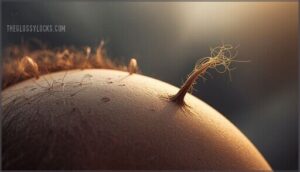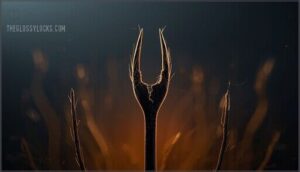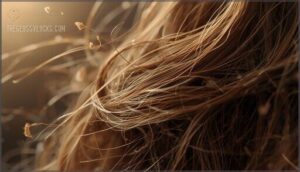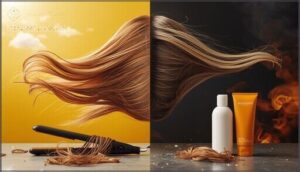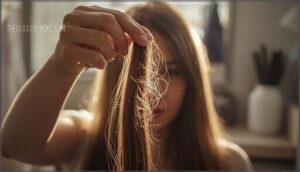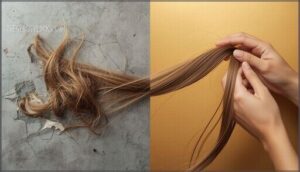This site is supported by our readers. We may earn a commission, at no cost to you, if you purchase through links.
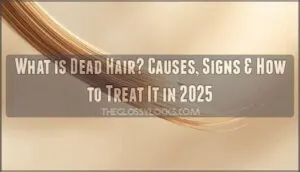
But here’s the truth that changes everything: the hair shaft emerging from your scalp contains no living cells, no blood supply, no nerve endings. It’s keratinized protein, and it’s been that way since it left the follicle.
So when you’re frantically searching for ways to revive your brittle, split-end-riddled strands, you’re not trying to resurrect dead tissue. You’re trying to repair damage to something that was never alive to begin with—and that distinction matters for how you approach treatment.
Table Of Contents
- Key Takeaways
- What is Dead Hair?
- How Does Hair Become Dead?
- Signs and Characteristics of Dead Hair
- Main Causes of Dead Hair
- How to Identify Dead Hair at Home
- Can Dead Hair Be Revived?
- Best Practices to Treat Dead Hair
- Preventing Dead Hair in The Future
- Frequently Asked Questions (FAQs)
- What is the difference between dead hair and damaged hair?
- Is it possible to revive dead hair?
- What are the best ways to care for dead hair?
- What are the signs that your hair is dead?
- What are the long-term effects of having dead hair?
- Does hair type affect dead hair risk?
- Can supplements reverse dead hair damage?
- How often should I trim dead hair?
- Is dead hair linked to scalp health?
- What ingredients repair dead hair best?
- Conclusion
Key Takeaways
- All hair is technically dead the moment it emerges from your scalp—it’s keratinized protein with no living cells, blood supply, or ability to heal itself—so when people say “dead hair,” they’re really describing visible damage to tissue that was never alive in the first place.
- You can’t truly revive or repair damaged hair because the structural breakdown of keratin bonds is permanent; treatments like masks and serums only temporarily coat the surface and improve appearance without restoring internal integrity.
- Heat styling above 300°F, chemical processing (bleaching, relaxers), and environmental stressors (UV exposure, pollution, hard water) are the primary culprits that weaken hair’s protein structure, causing brittleness, split ends, and loss of elasticity.
- Prevention through protective routines—trimming every 6-8 weeks, using sulfate-free products, limiting heat exposure to 200-300°F, and maintaining scalp health with proper nutrition—is far more effective than trying to fix damage after it’s already happened.
What is Dead Hair?
Here’s the thing about “dead hair”—it’s a term that gets tossed around a lot, but what does it actually mean? The truth is, all the hair on your head is technically dead tissue, yet we still use the phrase to describe hair that’s visibly damaged or lifeless.
Let’s break down what people really mean when they talk about dead hair, how it differs from damaged hair, and why the science matters.
Scientific Definition of Dead Hair
Here’s the thing: all your hair is technically dead the moment it pushes through your scalp. The visible hair shaft consists entirely of keratinized cells—hardened protein structures that lost their nuclei and metabolic activity during a process called cellular death. What you see isn’t living tissue but tightly packed keratin, nature’s premier protective protein composition.
Your hair follicle beneath the skin is alive and kicking, but everything above? That’s dead hair by biological definition. Understanding hair growth processes can help clarify this concept.
Dead Hair Vs. Damaged Hair
So while all hair is biologically dead, there’s a critical difference between “dead hair” and “damaged hair.” Dead hair has experienced such extensive damage—cracked cuticles, exposed cortex, zero elasticity—that it’s beyond repair. It won’t respond to protein repair or cuticle care.
All hair is biologically dead, but damaged hair—with cracked cuticles and zero elasticity—is beyond repair, unlike salvageable strands that still respond to treatment
Damaged hair, though? It’s compromised but still salvageable. You’ll see hair breakage and dullness, but deep conditioning and damage prevention can actually help. Hair restoration is possible for damaged strands, but truly dead hair needs the scissors.
Understanding the causes of hair damage issues is essential to preventing further damage and promoting hair health.
Colloquial Use of The Term
Outside the lab, though, you’re hearing “dead hair” everywhere—on Social Media, in beauty aisles, across friend groups. Linguistic Trends show a 39% spike in online use since 2020, driven largely by Cultural Perception and Beauty Standards.
Public Awareness is high: 97% know hair is technically dead keratin, yet they still say “dead hair” to describe:
- Strands so dry and brittle they snap at the slightest tug
- Dullness that no gloss or serum can fix
- Hair breakage and split ends signaling irreversible hair damage
- A loss of bounce or life that screams neglect
It’s metaphor meeting reality—shorthand for hair health gone off the rails.
How Does Hair Become Dead?
You might think hair “dies” from damage, but the truth is a bit more complex. Every strand on your head goes through a natural biological process that determines its fate.
Let’s break down how your hair transitions from living cells beneath your scalp to the strands you see in the mirror.
Hair Structure and Growth Cycle
Your scalp is a bustling factory, home to roughly 100,000 follicles that work around the clock to produce hair. Each follicle cycles through three distinct growth phases: anagen (the active growth period lasting 2-8 years, where 85-90% of your hair lives), catagen (a brief 2-3 week shift), and telogen (a resting phase of 2-3 months before shedding).
During anagen, your hair grows about 1 centimeter monthly, building layers of keratin-packed cells in the cortex and a protective cuticle that form the hair shaft you see and touch.
Keratinization and Non-Living Hair Cells
Within 24 to 72 hours, a striking transformation occurs in your hair follicle. Living cells lose their nuclei through keratinization—a process that converts them into rigid, protein-packed structures made of over 85% keratin.
These dead hair cells push upward, forming the visible shaft with tightly interlocked cuticle layers that give your hair strength.
Once exposed to oxygen, these keratinized cells become biologically inert, unable to repair hair damage or regenerate naturally—though their chemical bonds remain active, allowing certain hair treatments and protein bonds to improve appearance temporarily.
Signs and Characteristics of Dead Hair
You can spot dead hair by looking for a few telltale signs that show your strands have taken a beating.
Your hair sends clear signals when it’s damaged beyond its healthy state, and knowing what to watch for helps you address problems before they get worse.
Here’s what dead hair actually looks like.
Split Ends and Brittle Strands
When you run your fingers through your strands and they snap like dried twigs, that’s your hair waving a red flag. Split ends and brittle strands are the most visible markers of severe hair damage, and they show up in a few telltale ways:
- Split ends split into feather, fork, or tree patterns—mechanical testing shows damaged hair breaks after just 210 combing cycles versus 480 for healthy strands
- Brittleness spikes after heat exposure—lab tests found that 180°C styling for 10 minutes caused microfractures in 78% of fibers
- Bleaching accelerates fiber degradation—split frequency jumps 65% after chemical processing, with some splits stretching nearly 3 cm long
Your hair can’t heal itself once the damage sets in, but recognizing these signs early helps you stop the fracture before it travels up the entire strand.
Dryness, Roughness, and Dullness
Your hair might feel parched and look flat even after washing—that’s because lipid depletion, not water loss, drives the sensation of dryness. One study found that conditioned hair and untreated hair held identical moisture levels, yet treated strands felt 42% smoother. Heat styling above 95°C creates microscopic cracks that scatter light and kill shine, while environmental pollutants strip away the lipid barrier that gives hair its gloss. The result? Rough, porous strands that refuse to reflect light.
| Factor | Impact on Hair |
|---|---|
| Lipid Depletion | Causes rough texture and perceived dryness despite normal water content |
| Cuticle Damage | Leads to increased porosity, frizz, and reduced shine |
| Environmental Stress | Accelerates oxidative damage, roughness, and color fading |
Unmanageable and Tangled Hair
Tangles trap you in a vicious cycle—cuticle damage quadruples friction between strands, turning every brushing session into a hair-breaking marathon. When chemical treatments strip protective lipids, your hair grabs onto neighboring fibers like velcro, creating knots that resist even the best detangling tools.
This elevated hair friction doesn’t just frustrate you during your hair care routine; it mechanically stresses each strand until split ends and hair breakage become inevitable. Tangle prevention and knot reduction are essential for preserving hair smoothness and stopping further hair damage.
Main Causes of Dead Hair
Your hair doesn’t just wake up one day looking lifeless—it’s been through something. Heat, chemicals, sun exposure, and even the products you trust can all quietly chip away at your strands.
Let’s break down the main culprits behind dead, damaged hair so you know exactly what you’re up against.
Heat Styling Damage
Think flat irons and curling wands are just styling tools? They’re actually remodeling your hair at the molecular level. When you heat style above 300°F, you’re converting α-keratin into weaker β-keratin, permanently reducing elasticity and strength.
Cuticle lifting begins around 237°C, and by 428°F, over a third of strands won’t bounce back to their natural texture.
That’s why heat protectant matters—it cuts moisture loss by up to 50% and helps shield against breakage before your styling tools ever make contact.
Chemical Processing and Treatments
Bleach and relaxers don’t just alter your look—they dismantle your hair’s architecture from the inside out. Bleaching effects include a 60% drop in tensile strength and complete cuticle loss in nearly 80% of cases, while sodium hydroxide-based hair relaxers slash moisture retention by 40%.
Color treatments and oxidative dyes deplete keratin by up to 40%, and formaldehyde risks in smoothing products have been linked to elevated cancer rates, prompting FDA regulatory action in 2024.
Environmental Stressors and UV Exposure
Sunlight isn’t just fading your color—it’s breaking down your hair at a molecular level. UV exposure strips keratin, causes up to 60% protein loss, and generates free radicals that weaken every strand. Add air pollution, hard water, and humidity swings, and you’re facing a perfect storm of environmental toxins accelerating hair damage from sun exposure, moisture loss, and structural collapse.
What environmental stressors do to your hair:
- UV damage demolishes keratin proteins and triggers oxidative stress, leaving strands fragile and porous
- Air pollution clogs follicles with lead and mercury, sparking inflammation that can thin your hair by 30%
- Extreme humidity (above 65%) swells the cuticle and destabilizes protein bonds, causing relentless frizz
- Hard water minerals coat each strand with calcium buildup, roughening texture and draining elasticity
- Climate change extremes—from scorching heat above 140°C to bone-dry cold—disrupt moisture balance and deform keratin structure
Product Buildup and Improper Care
You can battle environmental damage all day, but if you’re piling on silicones, polymers, and heavy styling products without proper hair clarifying, you’re sealing in trouble. Product buildup creates a non-permeable barrier that traps dirt and sebum, cutting shine and elasticity by up to 30% within weeks.
Pair that with improper hair grooming practices—skipping washes, using harsh sulfates, or ignoring scalp residue—and you’ll see dullness, breakage, and even microbial overgrowth that weakens follicles.
Your hair care routine needs balance: gentle shampoos for regular cleansing, hair detoxing clarifiers once or twice a month, and enough washing frequency to prevent sebum oxidation without stripping natural oils.
How to Identify Dead Hair at Home
You don’t need fancy lab equipment to spot dead hair—your eyes and fingers are your best tools.
A few quick checks can tell you whether your strands are damaged beyond repair or just having a rough day. Here’s what to look for and how to test your hair at home.
Visual and Texture Cues
You don’t need lab tests to spot dead hair—your eyes and fingertips tell the story. Look for dull, flat strands with visible split ends and uneven thickness, especially near the tips.
Run your fingers through: if it feels rough, dry, or crunchy like straw, that’s brittle hair struggling with moisture retention. Healthy hair bounces back; dead hair tangles easily and snaps under gentle pressure.
Simple Hair Strand Tests
Beyond touch and sight, you can try quick at-home tests like the wet strand test—healthy hair stretches slightly when damp, while damaged strands snap immediately. The split-end test reveals fraying tips under light, and the bulb test checks if fallen strands shed naturally (with a white bulb) or broke mid-shaft.
While these aren’t the toxicology screening or drug detection methods used in hair follicle testing for strand analysis, they’re simple ways to assess your hair sample’s condition without a lab-based hair strand test or single-strand test.
Can Dead Hair Be Revived?
Here’s the truth you need to hear: once your hair is damaged, you can’t truly bring it back to life. The structural damage to those dead keratin cells is permanent, no matter what miracle products claim otherwise.
However, you can dramatically improve how your hair looks and feels, which is what most treatments actually do.
Limitations of Repairing Dead Hair
Once your hair exits the scalp, it’s made of protein that can’t regenerate—think of it like trying to heal a rope that’s already frayed.
Protein masks and bond-repair treatments improve surface feel, reducing hair breakage by up to 50%, but they don’t actually reverse structural weakness inside the strand. These products work like cosmetic masking, coating damage rather than fixing it.
Hair restoration requires new growth, not miracle formulas for treating damaged hair that’s already lost its integrity.
Improving Appearance Vs. True Restoration
The gulf between cosmetic treatments and true hair restoration is wider than most people realize. Products that promise hair repair can soften your strands and mask split ends, but they’re really about damage concealment, not follicle stimulation or biological hair revitalization.
- Deep conditioning masks coat dead hair shafts to improve texture, yet the internal damage remains unchanged
- Bond-repair serums reduce visible breakage but can’t restore structural integrity to already-damaged fibers
- Topical treatments may boost hair density by nearly 8% through scalp health, targeting new growth instead of fixing old strands
- Hair restoration therapies like PRP increase follicle density by roughly 31%, proving that real change happens at the root, not on dead hair itself
Best Practices to Treat Dead Hair
While you can’t truly bring dead hair back to life, you can dramatically improve its look and feel with the right approach. The key is combining immediate relief with long-term protection to stop the damage cycle.
Here’s what actually works to rescue your struggling strands.
Nourishing Hair Products and Masks
Think of nourishing products as intensive care for compromised strands—they’re your strongest defense against further deterioration. Weekly hair masks deliver concentrated moisture and proteins that temporarily bind split cuticles and restore flexibility to brittle sections. Look for formulations containing coconut oil, keratin, and natural oils like jojoba, which research shows can increase hair moisture by up to 11.4 times after a single use.
DIY recipes with honey and avocado offer budget-friendly alternatives, though professional products like Olive Fruit Oil Deeply Reparative Hair Mask often provide more consistent results. Integrating these treatments into your haircare routine—whether you prefer DIY recipes or product reviews to guide purchases—helps slow damage progression while improving manageability and shine.
| Ingredient Type | Key Benefits | Best For |
|---|---|---|
| Natural Oils (Coconut, Jojoba) | Deep moisture penetration, reduces breakage | Dry, brittle strands |
| Proteins (Keratin, Egg) | Reinforces structure, fills cuticle gaps | Chemically damaged hair |
| Humectants (Honey) | Locks in hydration, restores softness | Dull, dehydrated hair |
| Fatty Acids (Omega-3/6) | Nourishes follicles, enhances shine | Overall hair restoration |
| Antioxidants (Vitamin C, Selenium) | Protects from environmental stress | UV-exposed, weathered hair |
Hair nourishment won’t reverse damage permanently, but consistent application creates the appearance of healthier hair while preventing additional harm.
Regular Trims and Professional Treatments
You can’t fix the damage that’s already there, but regular trims every six to eight weeks remove split ends before they fracture upward—think of it as damage control that prevents minor issues from becoming major setbacks.
Hair stylists recommend preventative trims to maintain shape and reduce breakage, while professional treatments (keratin smoothing, bond repair) deliver scientifically backed restoration that home remedies can’t match.
Treatment costs range from $150 to $400, offering longer-lasting results than DIY alternatives when treating dead hair.
Reducing Heat and Chemical Exposure
Lowering your heat tool temperature to 200°F–300°F dramatically reduces damage risks—anything higher permanently weakens keratin structure and accelerates dead hair progression.
Chemical treatment alternatives like plant-based dyes or bond-building products protect hair integrity without harsh formaldehyde exposure.
Apply protective products before every heat styling session, and embrace behavioral change advice: air-dry when possible, limit chemical treatments to twice yearly, and prioritize preventing dead hair over constantly treating dead hair damage.
Preventing Dead Hair in The Future
You’ve tackled the damage—now let’s talk about keeping it from coming back. Prevention isn’t about being flawless, it’s about building habits that protect your hair before it loses its shine and strength.
Here’s how to keep your strands healthy and resilient moving forward.
Protective Hair Care Routines
Your hair needs a defense strategy, not just damage control. Protective hairstyles like braids, twists, and buns minimize daily manipulation and shield strands from environmental stressors—but style maintenance requires consistent scalp health attention.
Wash every 7-10 days to prevent buildup while preserving moisture. Best practices include nourishing hair masks, gentle detangling, and nutrition impact from protein-rich foods and hydration.
This hair care routine aids washing frequency balance and preventing hair damage through hair treatment tips that prioritize hair health improvement and hair moisture restoration.
Choosing Gentle, Sulfate-Free Products
Beyond protective styling, what you put on your hair matters just as much. Sulfates—the harsh detergents found in most shampoos—strip away natural oils that prevent dry hair and hair damage.
Switching to sulfate-free benefits your scalp sensitivity while preserving moisture, making dead hair less likely. Look for ingredient alternatives like coconut-derived cleansers in your product selection.
These sustainable options clean effectively without the brittleness, giving your hair repair products a fighting chance to actually work.
Lifestyle and Nutritional Tips for Hair Health
Your hair care tips work best when paired with smart nutrition. Dietary Impact on hair health runs deep—vitamin deficiencies in iron, zinc, or biotin trigger brittleness and shedding. Load up on fatty fish, leafy greens, and nuts to fuel hair growth from the inside.
Hydration Importance can’t be overstated; dehydration weakens strands instantly.
Stress Reduction through exercise boosts Scalp Circulation, delivering oxygen and nutrients where they’re needed most for hair health and maintenance.
Frequently Asked Questions (FAQs)
What is the difference between dead hair and damaged hair?
Every single strand on your head is technically dead—but damaged hair takes that reality to a whole new level. Dead hair refers to the visible shaft made of keratinized cells, which are naturally non-living.
Damaged hair, however, means structural integrity has been compromised through heat, chemicals, or environmental stressors, causing vitality loss, roughness, and reduced repair potential that makes strands look and feel worse.
Is it possible to revive dead hair?
Unfortunately, you can’t truly revive dead hair through cellular regeneration. Current treatments like masks and serums offer only temporary solutions—they improve appearance by coating damaged hair cuticles and providing cosmetic improvements, but they don’t restore hair at a cellular level.
True hair repair remains beyond today’s treatment efficacy, though future research continues exploring regenerative possibilities.
What are the best ways to care for dead hair?
You can’t truly resurrect damaged strands, but strategic care makes a visible difference.
Focus on deep conditioning hair masks weekly, gentle detangling from ends upward, and overnight protection with silk pillowcases to reduce friction and retain moisture.
What are the signs that your hair is dead?
Your hair is dead when you notice visual indicators like split ends and dullness, textural changes such as roughness and brittleness, and manageability issues including excessive tangling.
Hair breakage and severity levels vary with damage.
What are the long-term effects of having dead hair?
Over time, damaged strands lead to increased breakage rates and hair thinning, making your mane appear less dense.
Persistent follicle damage from chemical treatments can trigger scalp irritation and, in severe cases, contribute to hair loss patterns affecting overall volume.
Does hair type affect dead hair risk?
Your specific strands—whether fine, coarse, curly, or straight—dramatically shape your vulnerability to hair damage. Fine hair boasts higher tensile strength but snaps more easily under heat and mechanical stress, while thicker strands with compromised cuticle integrity develop split ends faster despite their structural advantages.
Can supplements reverse dead hair damage?
Unfortunately, Hair Growth Supplements can’t reverse damaged hair—since your hair shaft is already dead keratin outside the follicle.
However, nutrients like biotin, iron, and amino acids help strengthen new growth and reduce further breakage, supporting overall hair restoration rather than repairing existing damage.
How often should I trim dead hair?
Think of your strands like fraying rope—you can’t wait until the whole thing unravels.
Trim dead hair every 6-8 weeks to snip away split ends before they travel up the shaft, damaging your hair cuticle and sabotaging your hair restoration efforts.
Is dead hair linked to scalp health?
Absolutely—your scalp health plays a huge role in whether your hair becomes brittle and dead-looking.
Scalp inflammation disrupts hair follicles, while poor microbiome balance and oxidative stress weaken the scalp barrier, starving follicles of nutrients and oxygen they need to produce strong strands.
What ingredients repair dead hair best?
Hydrolyzed keratin and collagen are your top choices for protein repair—they fill micro-gaps and boost elasticity. Hyaluronic acid and glycerin restore moisture balance, while panthenol smooths the cuticle.
Silicones seal damage, and coconut oil or nourishing olive fruit oil shampoo deliver essential fatty acids for cuticle restoration.
Conclusion
Here’s the truth nobody wants to admit: what’s dead hair isn’t actually about dying—it’s about accepting that your strands were never alive. Once you stop chasing resurrection and start managing damage intelligently, everything changes.
Trim the broken ends, protect what’s left, and build routines that prevent destruction before it starts. Your hair doesn’t need a miracle cure; it needs you to understand what it actually is and treat it accordingly.
- https://www.hims.com/blog/is-hair-dead
- https://www.cocoandeve.com/blogs/news/dry-vs-damaged-hair
- https://steemit.com/science/@supersoju/damaged-human-hair-under-the-microscope
- https://www.wella.com/professional/en-US/blog/hair-care/how-to-fix-really-damaged-hair
- https://www.advancedhair.com/learn/dead-vs-dormant-can-your-hair-follicles-be-saved

